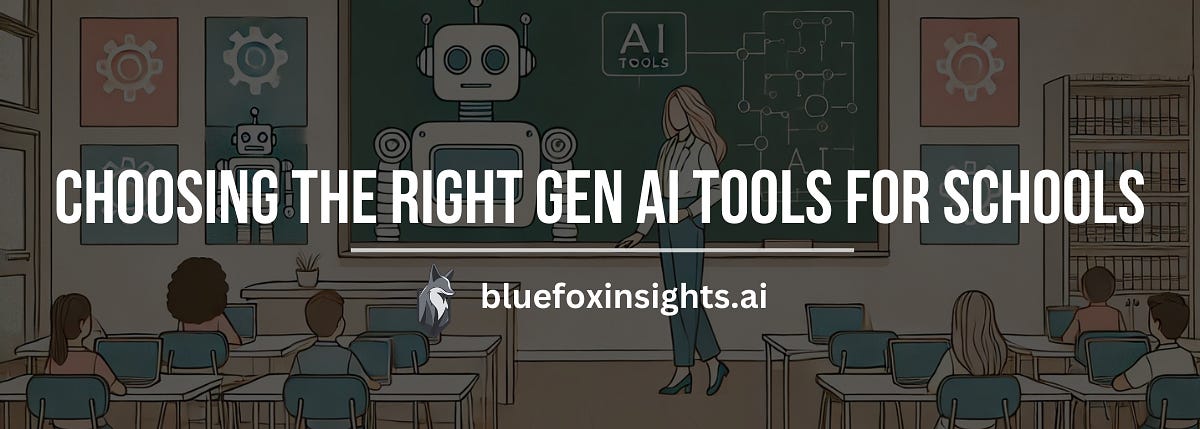How Should Schools Decide Which GenAI Tools to Use? Key Considerations for Superintendents and Their Staff
I was recently in a group meeting with numerous superintendents from Western Pennsylvania, where the topic of AI in education took center stage. They asked if I could begin writing articles to help guide school districts on what they should be considering as they navigate these new AI technologies. As Generative AI (GenAI) tools gain popularity, there’s immense potential for enhancing education—but that potential comes with complex challenges, particularly around data privacy, security, and the fast-evolving nature of AI. Here are the most important concepts superintendents and their staff need to think about when deciding which AI tools to allow in their schools.
Ask the Hard Questions About Data Privacy and Security
Before diving into specific tools, the first thing every school administrator must do is get clear answers on how data will be used. Generative AI systems are often trained using vast amounts of data, and this process, known as Reinforcement Learning from Human Feedback (RLHF), could pose serious risks if not properly handled.
When evaluating GenAI vendors, dig into their data practices and ask directly: “Will our data be used to train your models, even in an anonymized form?” The answer to this question is vital because even anonymized data can sometimes be reverse-engineered to reveal sensitive information. Additionally, how will the data be stored, who will have access, and for how long will it be retained? You need clear, transparent answers before making any decisions.
In my course The New AI Era for Business on Blue Fox Insights, I dive deeper into how GenAI tools like these work, explaining why it’s so important to be cautious with data privacy. Understanding the underlying mechanics of AI can help decision-makers grasp why even well-intentioned vendors might inadvertently misuse data. You do not have to watch the whole course, but at least watch these two videos that will give you a good foundation on how GenAI works: and
GenAI Tools Are Changing Rapidly—Be Wary of Long-Term Commitments
Another crucial point for superintendents to consider is the pace at which the GenAI landscape is evolving. New AI tools are being introduced at an astonishing rate, and many of them disappear just as quickly due to the fast advancement of the underlying technology. A tool that’s state-of-the-art today may become irrelevant in a matter of months, especially if it’s from a startup that lacks long-term viability.
Now, I want to be clear—I’m not trying to be negative about startups. In fact, I love startups! I run one myself. Startups bring innovation and fresh ideas to the market, and they’re vital to the tech industry. But for education, the stakes are higher, and school districts simply can’t take the same kinds of risks that companies can. That’s why, when it comes to selecting GenAI tools, it may make more sense to work with vendors you already have long-term relationships with. These companies provide a level of stability that’s crucial for ensuring continuity in education, though you should still vet their data privacy and security practices intensively.
Don’t Restrict the Tools Students Can Explore—Educate Them Instead
While it’s important to be cautious about data privacy and vendor stability, it's equally crucial not to limit the breadth of AI tools that your students can explore. By restricting them to a narrow set of pre-approved tools, you may inadvertently stifle their creativity and limit their potential to learn. GenAI offers students a unique opportunity to experiment with cutting-edge technology, but this also presents the need for guidance.
Rather than placing strict limits on what students can use, the focus should shift to educating them about the risks and challenges of GenAI—especially regarding data privacy and security. Teach students to ask the same hard questions that you’re asking vendors. Help them understand the trade-offs between using cutting-edge tools and protecting their own personal information. This approach not only enables them to use AI responsibly but also fosters critical thinking and deeper learning about the broader implications of AI in society.
Final Thoughts
Choosing which GenAI tools to allow in schools is no easy task, but by asking the right questions about data privacy, being mindful of the fast-changing nature of AI tools, and empowering students through education, superintendents can make informed, strategic decisions. Instead of committing to one tool or limiting what students can explore, the focus should be on fostering a safe, educational environment that teaches them to navigate the world of AI with wisdom and insight.
By taking a balanced approach—carefully evaluating vendors and their practices while encouraging responsible exploration of AI tools—schools can prepare students for a future where AI plays an ever-increasing role in both education and society.
I plan to continue writing on these important topics for K-12 education, especially as I come across tools or frameworks that I believe truly benefit our students. Stay tuned for more insights as we navigate the evolving world of AI in education together.
Resource:
One of my colleagues at Pitt recently compared the data privacy practices of ChatGPT and Claude, and you can find the analysis via this link. We need more of these kinds of analyses to help guide our decision-making as we move forward in this rapidly evolving AI landscape.
Author’s Note:
The ideas and content in these articles come directly from me, but I do engage in conversations with AI to get feedback on my thoughts before producing the final pieces. While AI helps me refine the structure and flow, all the insights and ideas are my own. These articles are NOT robo-generated.




